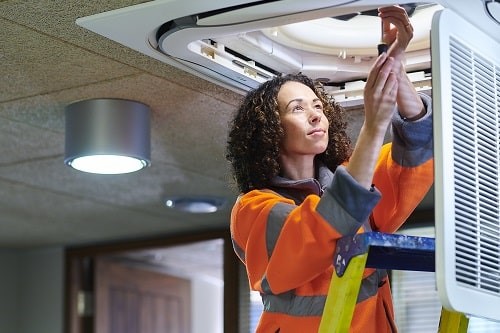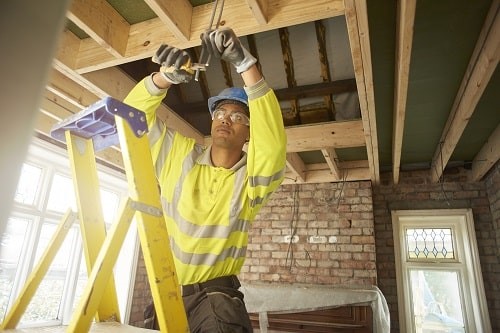When we spot distressing visuals of workers stranded on a wildly swinging platform at the top of a multistorey skyscraper we instantly know they are in danger. However, it is work at lower heights that often represents a major risk.
Features
How high is too high when it comes to safe working at height?
One of the most recent incidents happened in May this year in Oklahoma when news reports showed two window cleaners over an out-of-control platform that even has shattered glass on the building, prompting firefighters to evacuate the streets surrounding the tower. Luckily, both window cleaners were successfully ushered back to safety by a team of fearless emergency responders.
Named one of the world’s toughest jobs, skyscraper cleaning is naturally one of the best paid and thrilling jobs out there. Imagine juggling window squeegees and cleaning agents while simultaneously keeping your hands free to work your way from one surface to another? These challenges have created specific requirements for a safe working environment when cleaning windows at height: a workplace that offers a great deal of mobility in addition to having space for storing work tools.
But, somewhat counterintuitively, it is work at lower heights that often represents a major risk. Even a fall from a height as low as two metres above the ground carries the risk of a person sustaining serious injury or even resulting in a fatality.
 A fall from a height as low as two metres above the ground carries the risk of a person sustaining serious injury or even resulting in a fatality. Photograph: iStock
A fall from a height as low as two metres above the ground carries the risk of a person sustaining serious injury or even resulting in a fatality. Photograph: iStock
What’s more, the person may not fall on open ground and the risk of injury may be greater if the fall is onto objects below the workspace that could make the situation worse. Therefore, we should treat all work at height seriously – whether it’s a ‘low height’ or a ‘high height’ environment.
Figures provided by four of the UK’s most high-profile public works construction projects following a Freedom of Information (FOI) request earlier this year confirm that that 11 per cent of all health and safety incidents are related to working at height.
Of all respondents, Network Rail’s Crossrail project – the largest construction project in Europe – reported the highest number of total incidents, and highest number related to working at height – 321 and 35, respectively. Crossrail doesn’t build skyscrapers, but trains, platforms and stations, meaning that the average height at which workers operate should allow for preventable accident management, whether through thorough planning, comprehensive training, or use of certified equipment.
Each working at height accident is one too many, especially if entirely preventable. According to the Health and Safety Executive (HSE), approximately 609,000 cases of reportable work-related accidents occur in the UK each year. Last October it also revealed that, over the course of the last five years, falls from a height were responsible for 26 per cent of all fatal injuries, an average of 37 fatal injuries every year.
 Even when working at height feels like a second nature, the reality is that even a momentary lack of balance or vertigo can be a major risk
Even when working at height feels like a second nature, the reality is that even a momentary lack of balance or vertigo can be a major risk
These accidents aren’t restricted to mobile platforms with potentially more complex working conditions; they often involve ladders where heights are limited to two to four metres. Unfortunately, though rare, the most common cause of fatal accidents at work is falls from height.
While businesses should do their best to provide safe workplace environments, the role of regulators in stopping poor working at height practices cannot be underestimated. Yet, HSE’s latest 2019/2020 business plan makes no reference to tackling Britain’s biggest workplace killer.
What is the solution, you may ask. What can and should businesses be doing to ensure maximum safety and security for staff working at height? First of all, we need to accept that working at height is dangerous and stop thinking ‘it won’t happen to me’.
Even when working at height feels like a second nature, the reality is that even a momentary lack of balance or vertigo can be a major risk. Therefore, it’s always best to let the right equipment provide an extra layer of security. More complex working at height conditions involving electrical hazards, noisy equipment, oily or wet flooring, can also increase the risk of injury.
Therefore, it’s always best to use equipment specifically designed for the job. For example, mobile work platforms and ladders that are customised for a specific job, environmental conditions and location could provide an answer to the problem.
When selecting your equipment, ensure your ladders or platforms have stabilising legs or bars that prevent toppling over, feature special anti-slip treads with perforations to drain liquids where necessary and are made to the latest EN131 Professional standard. Mobile platforms and ladders used for construction, manufacturing or building maintenance projects should be built of material that can be used in situations where corrosive chemicals can be present, and that are durable enough to perform safely in all weather conditions for work outdoors.
Environmental influences such as ice, snow, high levels of humidity and the probability of strong winds should also be taken into account as they might strongly impair a mobile platform’s or a ladder’s slip resistance.
It is also important to ensure that you have both the necessary quality equipment, and that it is in good condition before starting any work at height. It is recommended that mobile platforms and ladders are subject to a pre-use check, as well as more detailed inspection at least once every three months.
In order to ensure equipment is safe, companies should ask their safety officer to perform a risk assessment as soon as possible. Effective safety management requires an individual risk assessment to take into account various factors before carrying out a task involving mobile platforms or ladders. These factors include the purpose of use and duration of the activity.
In light of the recent news and growing concerns regarding working at height, ZARGES emphasises the importance of regularly inspecting equipment used for even ‘minor’ jobs at lower heights and ensuring that the quality of those access systems is never willingly overlooked or compromised.
Russell Stuart is marketing manager at ZARGES
FEATURES

Underpinning safety training with neuroscience for long lasting impact
By SSE Active Training Team (ATT) on 30 November 2025
A behavioural safety training programme developed by Active Training Team for energy provider SSE has been carefully designed with neuroscientific principles in mind – resulting in a prestigious industry award for Best Training Initiative in 2024.

Why a painted line will never be enough
By UK Material Handling Association (UKMHA) on 20 November 2025
Businesses that operate material handling equipment like forklifts are being urged to submit accident and near miss details to a new confidential reporting portal so the industry can identify what needs to be done to improve safety standards.

Why workplace transport training is changing in 2026 and what it means for employers
By AITT on 26 November 2025
New workplace transport training categories due in January mean it is essential to ensure operators of material handling equipment have the necessary training for the exact type of machine they use, and accredited training providers are an ideal source of advice and conversion training.



